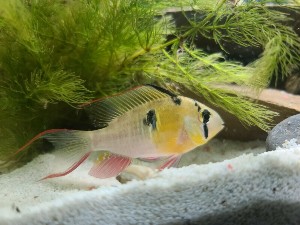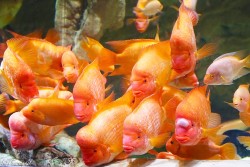Bolivian Rams (Mikrogeophagus altispinosus) CareSheet

Bolivian Rams, also known as Butterfly Rams and Red Rams, are social fish that form couples and are typically "loyal" to one another. The dorsal and caudal fins of Bolivian Rams have reddish highlights, while the pelvic and anal fins have pearly turquoise blue accents. A black'spot' goes from the top of the eye to the bottom of the head, with a black line running from the top of the eye to the bottom of the head.
A tank of at least 30 gallons is required for the Bolivian Ram. Several thick plant groupings and sufficient of free swimming area should be present in the tank. A few caves to hide in and stones to spawn on are also required by the Bolivian Ram. The Bolivian Ram is a calm fish that makes a great addition to a community tank and gets along with other gentle fish.
The Bolivian Ram is an egg layer that enjoys water with a mild to medium hardness, a neutral pH, and somewhat warmer temperatures (77-82°F). The water should be supplemented with peat. On stones and, on rare occasions, in depressions, the female will lay up to 200 eggs. The fry are reared by both the male and female, and they have been observed to take them into their mouths to protect them like a mouth brooder. It's important not to let the fry be sucked into the filter.
The Bolivian Ram is an omnivore that eats a broad range of foods. These fish will eat
freeze-dried bloodworms and
tubifex,
flake food, and both frozen and live brine shrimp and worms.
Requirements for keeping Mikrogeophagus altispinosus
Minimum Tank Size: 30 gallons
Care Level: Moderate
Tank Conditions: 72-79°F; pH 6.5-7.5
Max. Size In Aquarium: Up to 3"
Temperament: Peaceful
Diet: Omnivore

Bolivian Ram (Mikrogeophagus altispinosus)
Mikrogeophagus altispinosus species profile
Synonyms
Mikrogeophagus altispinosus is commonly known as the Bolivian Ram. It was previously classified under the name Apistogramma altispinosa.
Common names
The Bolivian Ram is the most widely used common name for Mikrogeophagus altispinosus.
Etymology
The species name "altispinosus" originates from Latin, where "altus" means high and "spinosus" means thorned. This refers to the distinctive spiky dorsal fin characteristic of this fish.
Classification
Mikrogeophagus altispinosus is a member of the family Cichlidae. It falls under the genus Mikrogeophagus and belongs to the order Perciformes.
Distribution
The Bolivian Ram is native to the upper Madeira River basin in Bolivia and Brazil, particularly in slow-moving waters of rivers and tributaries.
Habitat
In their natural habitat, Bolivian Rams inhabit areas with sandy or muddy substrates, submerged vegetation, and slow-moving waters. They prefer calmer, sheltered regions within rivers and streams.
Maximum Standard Length
Mikrogeophagus altispinosus typically grows to a maximum standard length of around 3 inches (7.5 cm).
Aquarium Size
An aquarium with a capacity of at least 20 gallons is recommended for a pair or small group of Bolivian Rams. Providing hiding spots and planted areas is important for their well-being.
Maintenance
Maintaining Bolivian Rams involves regular water changes, proper filtration, and providing a well-decorated aquarium with hiding places, driftwood, and plants.
Water Conditions
Bolivian Rams thrive in water temperatures of 75-82°F (24-28°C) and prefer slightly acidic to neutral pH levels (pH 6.0-7.5).
Diet
As omnivores, Bolivian Rams should be offered a varied diet that includes high-quality flakes, pellets, live or frozen foods such as brine shrimp, bloodworms, and small insects.
Behaviour and Compatibility
Bolivian Rams are generally peaceful and suitable for community aquariums with compatible species. They can be somewhat territorial during breeding but are less aggressive compared to other cichlid species.
Sexual Dimorphism
Sexual dimorphism is present, with males often having longer, more pointed dorsal fins, and brighter colors, while females may have a rounder body shape.
Reproduction
Bolivian Rams are substrate spawners and form monogamous pairs. They lay eggs on flat surfaces and both parents participate in guarding and caring for the eggs and fry.
Endangered List
Mikrogeophagus altispinosus is not listed as endangered.
 Bolivian Rams, also known as Butterfly Rams and Red Rams, are social fish that form couples and are typically "loyal" to one another. The dorsal and caudal fins of Bolivian Rams have reddish highlights, while the pelvic and anal fins have pearly turquoise blue accents. A black'spot' goes from the top of the eye to the bottom of the head, with a black line running from the top of the eye to the bottom of the head.
Bolivian Rams, also known as Butterfly Rams and Red Rams, are social fish that form couples and are typically "loyal" to one another. The dorsal and caudal fins of Bolivian Rams have reddish highlights, while the pelvic and anal fins have pearly turquoise blue accents. A black'spot' goes from the top of the eye to the bottom of the head, with a black line running from the top of the eye to the bottom of the head.



